Ever since the NHL Draft began in 1963, NHL teams have been utilizing it as the main way to bring in talent to their teams. For the teams that have been able to secure the first-overall pick, chances are they are drafting an exceptional player that can change the outlook of the team’s future.
Sometimes though – that’s just not the case.
You never truly know how a prospect will develop, if they’ll be able to translate their game to the NHL, or if they’ll “bust.” This was especially true when NHL teams were first starting to scout and analyze players for the draft, but it’s still evident in today’s game as well.
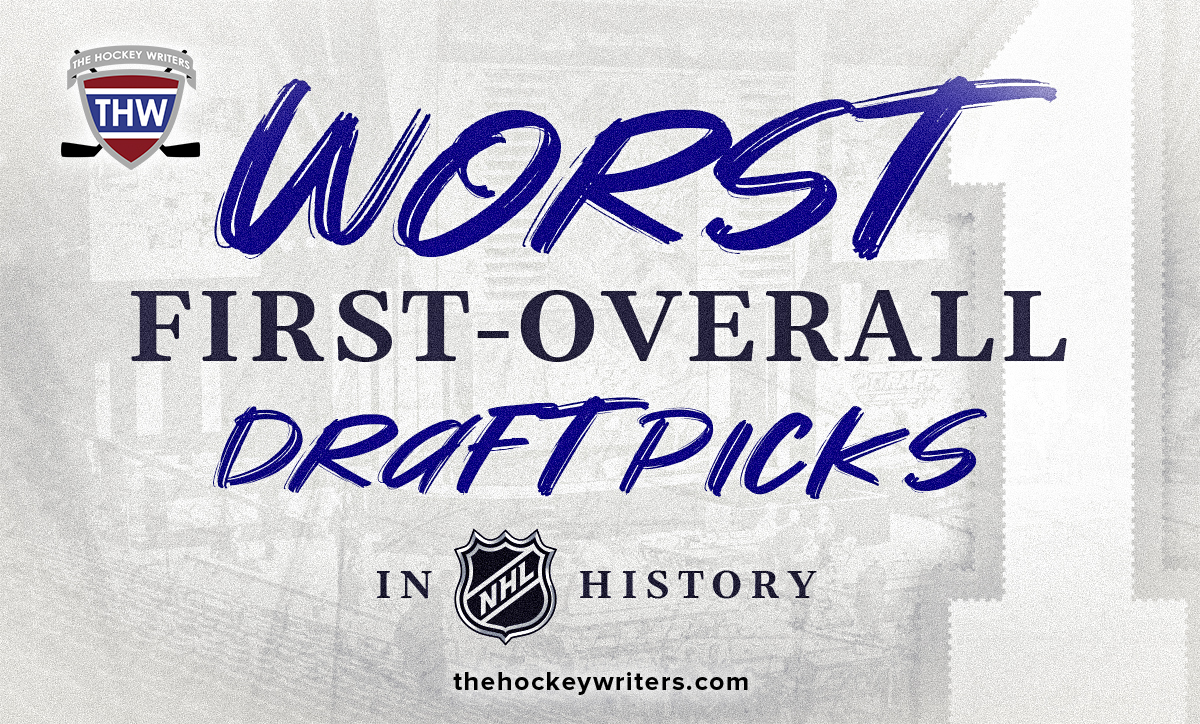
In this post, we’ll take a look at the 10 worst first-overall picks in NHL history and why they’ve earned the right to be on this list.
Spoiler: there’s a three-way tie for first.
10) Alexandre Daigle, Ottawa Senators (1993)
NHL Career: 616 Games, 129 Goals, 198 Assists, 327 Points
The next great superstar to hit the NHL, the Ottawa Senators landed the undisputed No. 1 prospect in the 1993 NHL Entry Draft when they picked Alexandre Daigle. Or so they thought.
Related: What Ever Happened to Alexandre Daigle?
Daigle came into the league after collecting 247 points in 119 QMJHL games for the Victoriaville Tigres. He was so highly touted that the Quebec Nordiques offered players like Owen Nolan, Peter Forsberg, and Ron Hextall, as well as draft picks, in order to draft the next great French Canadian. (from: “HOCKEY; As Expected, Senators Make Daigle Top Pick” – NYTimes – June 27, 1993). But the Senators refused and selected him with their top pick.
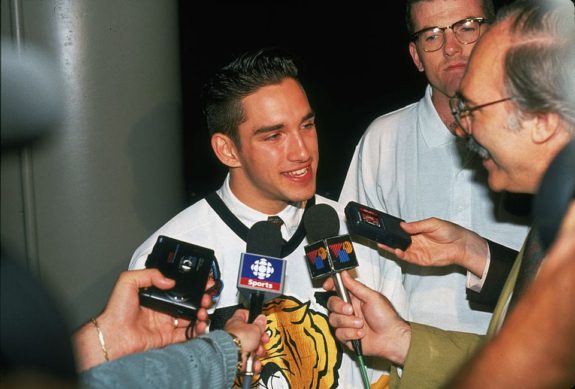
In his first season, he potted 20 goals and collected a career-high 51 points (he did hit it twice more through his career). But it’s safe to say he never blossomed into that player that was supposed to be. He was given a massive contract of five-years $12.5 million to start his career (later leading to the entry-level contract salary caps) and seemed to never give enough effort on the ice.
“I’m glad I got drafted first because no one remembers number two.”-
Alexandre Daigle after being drafted. Selected No. 2 was future Hall of Famer Chris Pronger
Many would place Daigle higher on this list given the hype surrounding him leading to the draft, but he did end up playing 616 NHL games and collecting 327 points. Not exactly what was expected of him, but better than many players have in their NHL careers – and those on the rest of this list.
9) Brian Lawton, Minnesota North Star (1983)
NHL Career: 483 Games, 112 Goals, 154 Assists, 266 Points
While Brian Lawton finds himself on this list, it doesn’t change the history that he made. The centreman was the first American-born player to ever be drafted first overall and he’s the only first-overall pick to ever be selected out of a U.S. high school.
Lawton entered the draft after racking up 171 points in his two seasons prior for Mount St. Charles Academy and played for Team USA at the World Juniors and the World Championship. The Minnesota North Stars selected him above players such as Pat LaFontaine, Steve Yzerman, and Cam Neely. Whoops.
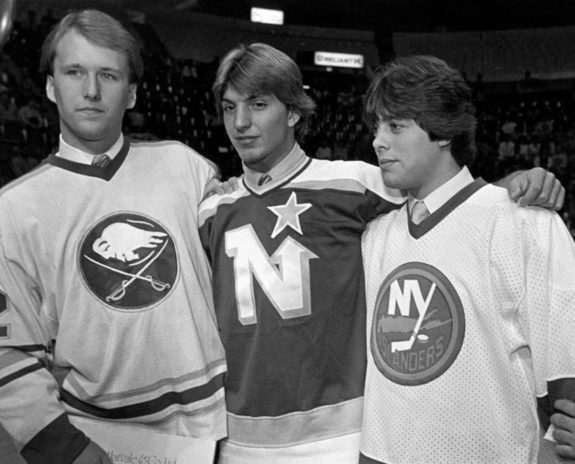
Lawton made the jump straight to the North Stars after being convinced by the team to turn professional. He played five seasons for the North Stars, putting up respectable numbers (162 points in 303 games) but never living up to the first-overall status.
He was then traded to the New York Rangers and spent the remainder of his career jumping from the NHL to the AHL, to the IHL and back. From 1987 to 1993, he played for seven NHL teams, three IHL teams, and one AHL team. In 1989-90, he played for four different teams (three NHL).
8) Patrik Stefan, Atlanta Thrashers (1999)
NHL Career: 455 Games, 64 Goals, 124 Assists, 188 Points
The 1999 NHL Draft is arguably the worst in history and it starts right at the top with Atlanta Thrashers selection Patrik Stefan. It’s even worse when you take a look at the two players taken after him: Daniel and Henrik Sedin.
Related: 1999: The Worst NHL Draft Class Ever?
The Czech centreman played for HC Sparta Praha in the Czech league and then the Long Beach Ice Dogs of the IHL prior to the NHL. The IHL was then considered the second-best league in the world and Stefan – despite being held to just 33 games in his draft year due to a concussion – was an all-star.
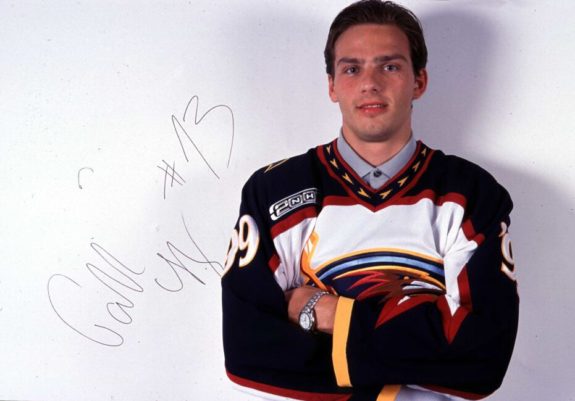
He then spent just seven seasons in the NHL, six of which with the Thrashers and one with the Dallas Stars where he will be forever remembered for one of the worst mistakes in the history of the NHL. He never scored more than 14 goals or 40 points (his career highs).
Overall, Stefan disappointed in his NHL career but he can’t be entirely held at fault. Stefan shouldn’t have been taken first overall and wouldn’t have been if it wasn’t for Brian Burke. Burke made a series of trades to ensure that he landed the Sedin twins for the Vancouver Canucks and in those dealings, he got the Thrashers the first-overall pick with the assurance that they wouldn’t select a Sedin. Stefan still would have been a bust, but not a part of this list at least.
7) Greg Joly, Washington Capitals (1974)
NHL Career: 365 Games, 21 Goals, 76 Assists, 97 Points
We’re going back a number of years for this one, back when the draft was still referred to as the NHL Amateur Draft. In 1974, the Washington Capitals were joining the NHL as an expansion team and were granted the first-overall pick in the draft. They chose Greg Joly.
Related: The Worst 1st Overall Draft Pick…Ever
Joly came into the draft hot, coming off a 92-point season with the WHL’s Regina Pats, followed up with a 20-point playoff performance in 16 games. He led the Pats to a Memorial Cup championship and was named the Memorial Cup MVP. He was a hot commodity.
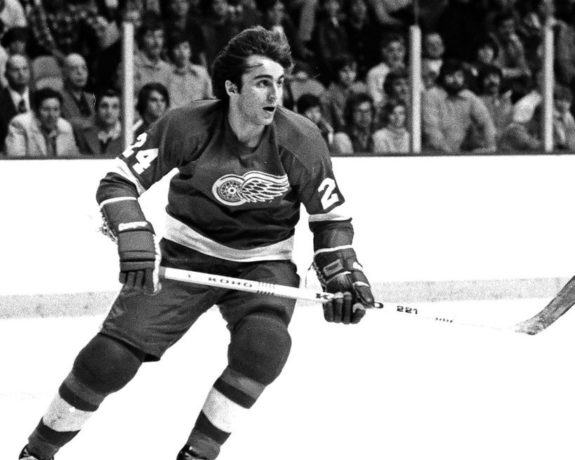
First Capitals’ general manager, Milt Schmidt, was the man at the helm of this decision, touting Joly as the “next Bobby Orr.” With 97 points in 365 games, I think it’s safe to say that Joly did not live up to that hype. His career was spent bouncing between the AHL and NHL, with the majority in the AHL.
It also wasn’t with the Capitals. Joly spent just 98 games (collecting 33 points and racking up a whopping minus-116) with the team that drafted him before being traded to the Detroit Red Wings. He spent the rest of his career with the Red Wings organization, winning two Calder Cup championships with the Adirondack Red Wings. His NHL career saw him finish with a minus-165 plus/minus.
6) Nail Yakupov, Edmonton Oilers (2012)
NHL Career: 350 Games, 62 Goals, 74 Assists, 136 Points
The most recently-drafted player on this list, everyone knows the story of Nail Yakupov. After dominating the OHL with the Sarnia Sting for 170 points in 107 games and terrorizing teams at the international level, the Edmonton Oilers used their third-straight first-overall pick on Yakupov.
After being drafted, Yakupov headed to the KHL’s Neftekhimik Nizhnekamsk for the half locked-out 2012-13 season, collecting 18 points in 22 games. Not bad, things still looked good for the young player. He then made the jump to the NHL that year, racking up 31 points in 48 games.
From there, the Russian winger stagnated. He played just three more campaigns for the Oilers, only crossing 30 points once (33 points in 2014-15). They decided to move on from him, trading him to St. Louis for Zach Pochiro, who never played an NHL game.
Related: 2012 Redraft: What if the Edmonton Oilers Didn’t Take Nail Yakupov?
He collected only nine points in 40 games and the Blues let him walk into free agency. The Colorado Avalanche gave him a shot on a one-year deal where he potted 16 points in 58 games. That was it for Yakupov, who headed back to the KHL for the 2018-19 season. He has played the last five seasons there for SKA St Petersburg, Khabarovsk Amur, and Omsk Avangard and scored only 53 goals in 186 games.
5) Rick DiPietro, New York Islanders (2000)
NHL Career: 318 Games, 2.87 GAA, .902 SV%
Another more-recent first-overall pick, Rick DiPietro last played an NHL game in 2012-13 before getting bought out in the 2013 offseason. But he continues to get paid by the New York Islanders until the end of the 2028-29 season.
DiPietro is an interesting case because the Islanders took a chance on him just three years after drafting another goaltender, Roberto Luongo, fourth overall. The Islanders felt that DiPietro had a better future ahead of him than Luongo and traded the latter to the Florida Panthers. It did not work out that way.
DiPietro was supposed to be the next best goalie in the NHL after dominating the 2000 World Juniors and the NCAA for Boston University. He did play 318 games for the Islanders, occasionally looking like an average starting goaltender, but more often than not, he struggled in the net.
To make matters worse and pile on to the hype that he simply couldn’t live up to, in 2006 the Islanders signed him to a massive 15-year contract worth $67.5 million. But between the contract, his struggles, the team’s struggles, and a series of injuries that seriously limited his play, there was simply no living up to the first-overall pick standards.
4) Gord Kluzak, Boston Bruins (1982)
NHL Career: 299 Games, 25 Goals, 98 Assists, 123 Points
If not for injuries, 1982 first-overall pick Gord Kluzak might not be on this list. But, from the other players that were available to the injuries the preceded his draft selection, the warning signs were there.
Playing for the Billings Bighorns in the WHL, the defender impressed, putting up 71 points in 106 over two seasons. However, he also missed half of his draft year after tearing the ligaments. Still, general manager Harry Sinden believed in the young player and selected him with the top pick.
Some of the players that were drafted after Kluzak make it worse for the selection. Immediately after him was Brian Bellows, and the top 10 saw Ron Sutter, Scott Stevens, and Phil Housley. Later on, players like Dave Andreychuk, Pat Verbeek, Ray Ferraro, and Doug Gilmour were taken. This was a very good draft year, but Kluzak didn’t help that.
His 299 games were spread across seven seasons but nine years, with two seasons in the middle (1984-85 and 1986-87) seeing him miss the entire campaigns with knee injuries. Plus, his last three seasons saw him play just 3, 8, and 2 games before he hung up his skates. Had it not been for injuries, perhaps he might not be on this list, but looking at the names taken after him, it especially doesn’t help his case.
The 3 Worst First-Overall Picks in NHL History
These top three players came in the early years of the NHL Amateur Draft, but that doesn’t discount the fact that these were the worst first-overall picks in history. In the history of the NHL Draft, these are the only three first-overall picks to never play a single game in the NHL.
The teams were just beginning to understand what to look for in the draft and for the first few years, it really didn’t go well. Here are the top three, all tied for the worst spot, in order of draft year:
Claude Gauthier, Detroit Red Wings (1964)
In full fairness to Claude Gauthier, the first four picks in this draft didn’t play an NHL game. Of the 24 players taken in this draft, only nine of them played a game. But, that did include Hall of Famers Ken Dryden (14th) and Syl Apps (21st). The stats from this time are pretty barren, but no NHL stats make it pretty clear: Gauthier was the first NHL Draft bust, coming in just the league’s second draft.
Andre Veilleux, New York Rangers (1965)
It seems that the New York Rangers didn’t learn from the Detroit Red Wings from the previous draft, because they drafted right-winger Andre Veilleux first overall, never to play an NHL game. However, once again the top-four players draft didn’t play a single game. Only 11 players were drafted this year – only two played a single NHL game. Veilleux is a draft bust, but really, this entire draft is a bust.
Rick Pagnutti, Los Angeles Kings (1967)
After a pretty successful 1966 NHL Draft, the 1967 edition came back down to join 1964 and 1965. Rick Pagnutti was one of 18 players selected, with just three making it to the NHL. Pagnutti at least went on to have a fairly lengthy professional career, seeing time in the AHL, IHL, CHL, WHL, and NAHL, winning the IHL’s Best Defenseman in 1971-72. He didn’t reach the NHL, but at least he did continue on professionally.
With the advancements in scouting and player development, we’re unlikely to see this list change very much moving forward. However, we’re not that far removed from Yakupov being selected by the Oilers so you never really know. Anything can happen that results in a first-overall pick not succeeding at the next stage.
What do you think of this list? Who’s missing? Who doesn’t deserve to be on this list? How would you re-arrange it? Leave your answers in the comment section below!
Sign up for our NHL History Substack newsletter

You have to feel bad for them. Playing in the NHL is so many little boys dream and to actually get there (first overall too!) and be a bust. It must be devastating.
“Nobody remembers No. 2, boys, nobody remembers No. 2 ” Chris Pronger quoting Alexander Daigle after Daigle went before Pronger in the draft.
Anyone putting gord kluzak on this list is an idiot! He was the victim of one of the cheapest knee on knee its evah!!!!!
Gord Kluzak suffered a devastating knee injury, the reason he only played 299 games. His point per game was .41, Serge Savard, a hockey hall of famer was .42 for his career. I figure you are Canadian and therefore need to have a Bruin on your list, but if people used your train of thought Thurman Munson was not that good of a catcher as he only played 9 full seasons, averaging 13 homeruns and 80 RBI.
And how many Stanley Cups has Crosby won? Yes, 1 more than Kluzak. The Wild must love the knowledge you spew for them.
I totally agree with North Central and cannot believe that Doug Wickenheiser is not on this list. Back in the eighties, he or Lawton would have topped the list. Joe Murphy was in danger of going down the same path when he was stuck in Adirondack, but then he got traded, won the cup with Edmonton and ended up having a stellar career.
Daigle, was talented but lacked heart and him being labelled a bust is amplified by the fact that he was the first pick in one of the richest drafts in NHL history.
Someone commented/mentioned Erik Johnson?! Same problem that Daigle had and there is NO way that he is worse than Chris Phillips, it’s just that Phillips was drafted first overall in probably one of the weakest crops in the history of the NHL draft.
Don B (Beaupre? :D), I totally agree with your assenssment on DP. Milbury has got the be the worst GM in the history of sport.
As mentioned by others, I don’t think it’s fair to list a player as a “bust” if it was injuries that cut his time short.
Having said that, maybe one should look at Rick Nash as being a bust. Been in the league for 12 years now, has been the highest paid player on his team for a whiel, and has yet to score an NHL playoff goal against a legit #1 goalie
I agree with Don B and want to lump Kluzak with DP. A bust is someone that gets tot he league and, for some reason, fails to perform. DP and Kluzak were beasts when healthy. Injury always exonerates a person off my “bust” list.
Im amazed Erik Johnson isnt on here. He never really lived up to the hype at all and when you look at the players the Blues COULD have taken and the players that went number one in the years around that draft it looks really bad.
NHL scouts and GMs rate a draft pick as successful if that player suits up for greater than 200 games in the NHL (or equivalent pro leagues, i.e., the WHA back in the 70’s), regardless of which team(s) he plays for in those games. That’s their binary definition of success.
Erik Johnson = 428 and counting.
How can Doug Wickenheiser be left out of this list. Based on his Junior career in Regina, Everyone in the world had him at number one. It took Montreal a long time to recover from that pick.
NHL scouts and GMs rate a draft pick as successful if that player suits up for greater than 200 games in the NHL (or equivalent pro leagues, i.e., the WHA back in the 70’s), regardless of which team(s) he plays for in those games. That’s their binary definition of success.
Wickenheiser = 556.
Then again, DP got his face busted by Brett Johnson, Penguins G. That was AWESOME!!!
The more interesting thing to note about the NHL draft is that, if you look at mature drafts (the players have now finished their careers; i.e., drafts from 1969-1993) and bin the picks by round, then take the average and standard deviation of “number of NHL man-games per draft pick” within each bin, after round 2 the standard deviation is substantially larger than the average. Meaning: it’s all noise after round 2 and teams could throw darts at the dart board from rounds 3 onward and they’d get the same results.
Greg Joly, the Caps 1st ever draft choice. They passed over Mike Bossy to pick Joly.
Greg Joly went #1 in the 1974 draft.
Mike Bossy went #15 in the 1977 draft.
The reason why 1963-68 yielded almost no real NHL talent (Ken Dryden & Brad Park being exceptions) is because all the top players that came of age (20 years old) during those drafts had already been scooped up via the old system of C-forms (consent forms) when they were 12-14 years old, not because scouts were incompetent. Once all those legacy C-form players had graduated juniors (1969), then the draft became meaningful.
Bellows scored over a 1,000 points in his career. There were a handful of better players in that draft that him but Bellows was talented and did well in the NHL over an extended period of time.
Kluzak was a big and talented Saskatchewan guy. He just couldn’t stay healthy. If he’d stayed healthy this list would have to talk about someone else.
There was a good reason Gord Kluzak was taken by the Bruins – they were given two players by the North Stars to NOT select Brian Bellows with that number one pick. The North Stars wanted Bellows so badly that in three separate transactions, they gave up seven players to make sure they drafted Bellows with the #2 selection that year. He wasn’t a total bust, but not worth that price.
And speaking of the North Stars, they thought so highly of Brian Lawton that they gave him #98 for his jersey – thinking he was just one notch below Gretzky. At least he has had a successful run as an agent – there are worse things that can happen after an unsuccessful hockey career.
The end of the Stafan part was classic
I think if you are considering DiPietro one of the worst #1 picks ever, then you need to nominate it based on the management of the team (Milbury) and not on DP himself. First, DP shouldn’t have gone that high – but that’s not his fault. Second, the contract (Snow) was crazy too. But what the problem with DP wasn’t his ability or even stats, it’s that he couldn’t stay healthy. It’s hard to blame a player for that. When he was truly healthy, DP was a solid #1 goalie. To me, a bust pick is a guy that was touted for his exceptional skills, but when he played he never showed those skills. DP showed those skills when he was able to play healthy. The latter years were an unfair judgement because after his surgeries, he was never really able to do what made him such a good player.